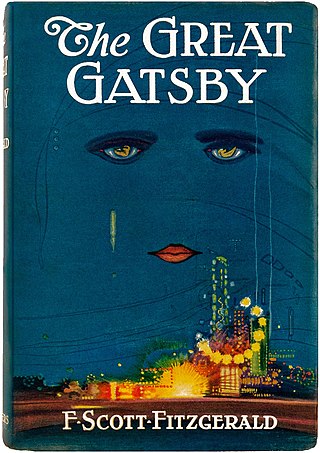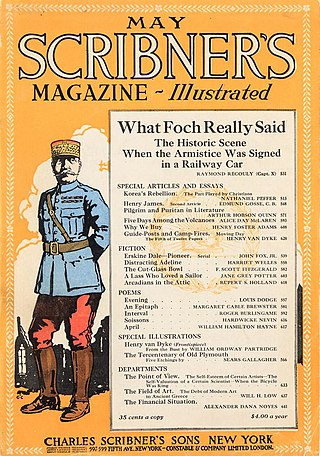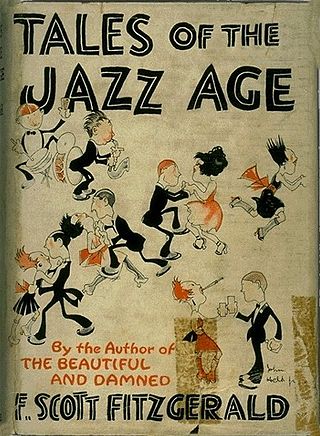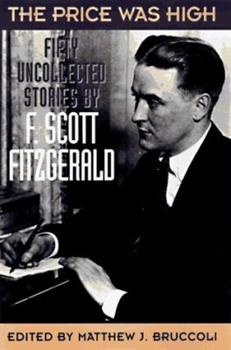
The Great Gatsby is a 1925 novel by American writer F. Scott Fitzgerald. Set in the Jazz Age on Long Island, near New York City, the novel depicts first-person narrator Nick Carraway's interactions with Jay Gatsby, the mysterious millionaire with an obsession to reunite with his former lover, Daisy Buchanan.

Zelda Fitzgerald was an American novelist, painter, and socialite. Born in Montgomery, Alabama, to a wealthy Southern family, she became locally famous for her beauty and high spirits. In 1920, she married writer F. Scott Fitzgerald after the popular success of his debut novel, This Side of Paradise. The novel catapulted the young couple into the public eye, and she became known in the national press as the first American flapper. Because of their wild antics and incessant partying, she and her husband became regarded in the newspapers as the enfants terribles of the Jazz Age. Alleged infidelity and bitter recriminations soon undermined their marriage. After Zelda traveled abroad to Europe, her mental health deteriorated, and she had suicidal and homicidal tendencies, which required psychiatric care. Her doctors diagnosed her with schizophrenia, although later posthumous diagnoses posit bipolar disorder.

This Side of Paradise is a 1920 debut novel by American writer F. Scott Fitzgerald. It examines the lives and morality of carefree American youth at the dawn of the Jazz Age. Its protagonist, Amory Blaine, is a handsome middle-class student at Princeton University who dabbles in literature and engages in a series of unfulfilling romances with young women. The novel explores themes of love warped by greed and social ambition. Fitzgerald, who took inspiration for the title from a line in Rupert Brooke's poem Tiare Tahiti, spent years revising the novel before Scribner's accepted it for publication.

The Beautiful and Damned is a 1922 novel by American writer F. Scott Fitzgerald. Set in New York City, the novel's plot follows a young artist Anthony Patch and his flapper wife Gloria Gilbert who become "wrecked on the shoals of dissipation" while partying to excess at the dawn of the hedonistic Jazz Age. As Fitzgerald's second novel, the work focuses on the swinish behavior and glittering excesses of the American idle rich in the heyday of New York's café society.

"Bernice Bobs Her Hair" is a short story by F. Scott Fitzgerald, first published in May 1920 in The Saturday Evening Post. It was Fitzgerald's first short story to achieve national prominence. The original publication featured interior illustrations by May Wilson Preston. The work appeared in the September 1920 short story collection Flappers and Philosophers published by Charles Scribner's Sons.

"The Cut-Glass Bowl" is a short story by American author F. Scott Fitzgerald, first published in the May 1920 issue of Scribner's Magazine, and included later that year in his first short story collection Flappers and Philosophers. The story follows the lives of a married couple, Evylyn and Harold Piper, through various difficult or tragic events that involve a cut glass bowl they received as a wedding gift. In a copy of Flappers and Philosophers which he gave to literary critic H. L. Mencken, Fitzgerald wrote that he deemed the story to be "worth reading" in contrast to others in the volume which he dismissed as either "amusing" or "trash."

"Head and Shoulders" is a short story by F. Scott Fitzgerald. It was his first story to be published in the Saturday Evening Post, with the help of Fitzgerald's agent, Harold Ober. The story appeared in the February 21, 1920 issue and was illustrated by Charles D. Mitchell. It later appeared in his short story collection Flappers and Philosophers.

"Benediction" is a short story by American author F. Scott Fitzgerald, first published in 1920 in the February 1920 issue of The Smart Set. It was republished shortly thereafter in Fitzgerald's short story collection Flappers and Philosophers.

"The Ice Palace" is a modernist short story written by F. Scott Fitzgerald and published in The Saturday Evening Post on May 22, 1920. It is one of eight short stories originally published in Fitzgerald's first collection, Flappers and Philosophers, and is also included in the collection Babylon Revisited and Other Stories.

Tales of the Jazz Age (1922) is a collection of 11 short stories by American writer F. Scott Fitzgerald. Divided into three separate parts, it includes one of his better-known short stories, "The Curious Case of Benjamin Button". All of the stories had first appeared, independently, in either Metropolitan Magazine, The Saturday Evening Post, Smart Set, Collier's, the Chicago Sunday Tribune, or Vanity Fair.

Francis Scott Key Fitzgerald, widely known simply as Scott Fitzgerald, was an American novelist, essayist, and short story writer. He is best known for his novels depicting the flamboyance and excess of the Jazz Age, a term he popularized in his short story collection Tales of the Jazz Age. During his lifetime, he published four novels, four story collections, and 164 short stories. Although he achieved temporary popular success and fortune in the 1920s, Fitzgerald received critical acclaim only after his death and is now widely regarded as one of the greatest American writers of the 20th century.

All the Sad Young Men is a collection of short fiction by American writer F. Scott Fitzgerald. The stories originally appeared independently in popular literary journals and were first collected in February 1926 by Charles Scribner's Sons.

"The Offshore Pirate" is a short story written by F. Scott Fitzgerald in 1920. It is one of eight short stories included in Fitzgerald's first published collection, Flappers and Philosophers. The story was first published in the May 29, 1920 issue of The Saturday Evening Post and illustrated by Leslie L. Benson.

Taps at Reveille is a collection of 18 short stories by American writer F. Scott Fitzgerald, published by Charles Scribner's Sons in 1935. It was the fourth and final volume of previously uncollected short stories Fitzgerald published in his lifetime. The volume appeared a year after his novel Tender is the Night was published. The collection includes several stories featuring autobiographical creations derived from Fitzgerald's youth, namely Basil Duke Lee and Josephine Perry.

"The Rich Boy" is a short story by American writer F. Scott Fitzgerald. It was included in his 1926 collection All the Sad Young Men. "The Rich Boy" originally appeared in two parts, in the January and February 1926 issues of Redbook. In the January installment, the story is described on the front cover as: "A great story of today's youth by F. Scott Fitzgerald".
"Absolution" is a short story by American writer F. Scott Fitzgerald. It was included in his 1926 collection All the Sad Young Men.
"Echoes of the Jazz Age" is a short essay by American writer F. Scott Fitzgerald that was first published in Scribner's Magazine in November 1931. The essay analyzes the societal conditions in the United States which gave rise to the flowering of youth culture in the raucous historical era known as the Jazz Age and the subsequent events which led to the era's abrupt conclusion. The frequently anthologized essay represents an extended critique by Fitzgerald of 1920s hedonism and is regarded as one of Fitzgerald's finest non-fiction works.
"Myra Meets His Family" is a work of short fiction by F. Scott Fitzgerald first appearing in The Saturday Evening Post on March 20, 1920. The story was collected in The Price Was High: Fifty Uncollected Stories by F. Scott Fitzgerald (1979) by Harcourt, Brace & Company "Myra Meets His Family" was among the first stories accepted by The Saturday Evening Post for publication. Fitzgerald would sell the bulk of his short fiction to the Post during the next 20 years, until his death n 1940.

The Price Was High: Fifty Uncollected Stories by F. Scott Fitzgerald is a volume of short fiction by F. Scott Fitzgerald published by Harcourt Brace & Company in 1979.
“The Lees of Happiness” is a work of short fiction by F. Scott Fitzgerald first appearing in The Chicago Tribune, December 12, 1920. The story was first collected in Tales of the Jazz Age (1922) published by Charles Scribner’s Sons.

















